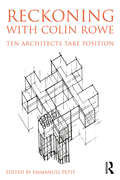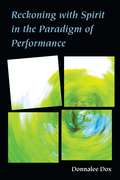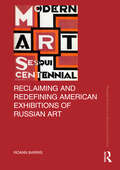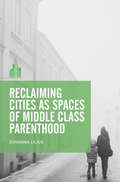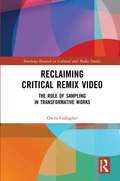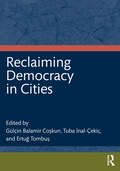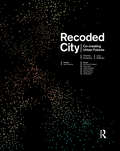- Table View
- List View
Reciprocal Landscapes: Stories of Material Movements
by Jane HuttonHow are the far-away, invisible landscapes where materials come from related to the highly visible, urban landscapes where those same materials are installed? Reciprocal Landscapes: Stories of Material Movements traces five everyday landscape construction materials – fertilizer, stone, steel, trees, and wood – from seminal public landscapes in New York City, back to where they came from. Drawing from archival documents, photographs, and field trips, the author brings these two separate landscapes – the material’s source and the urban site where the material ended up – together, exploring themes of unequal ecological exchange, labor, and material flows. Each chapter follows a single material’s movement: guano from Peru that landed in Central Park in the 1860s, granite from Maine that paved Broadway in the 1890s, structural steel from Pittsburgh that restructured Riverside Park in the 1930s, London plane street trees grown on Rikers Island by incarcerated workers that were planted on Seventh Avenue north of Central Park in the 1950s, and the popular tropical hardwood, ipe, from northern Brazil installed in the High Line in the 2000s. Reciprocal Landscapes: Stories of Material Movements considers the social, political, and ecological entanglements of material practice, challenging readers to think of materials not as inert products but as continuous with land and the people that shape them, and to reimagine forms of construction in solidarity with people, other species, and landscapes elsewhere.
Reciprocal Landscapes: Stories of Material Movements
by Jane HuttonHow are the far-away, invisible landscapes where materials come from related to the highly visible, urban landscapes where those same materials are installed? Reciprocal Landscapes: Stories of Material Movements traces five everyday landscape construction materials – fertilizer, stone, steel, trees, and wood – from seminal public landscapes in New York City, back to where they came from. Drawing from archival documents, photographs, and field trips, the author brings these two separate landscapes – the material’s source and the urban site where the material ended up – together, exploring themes of unequal ecological exchange, labor, and material flows. Each chapter follows a single material’s movement: guano from Peru that landed in Central Park in the 1860s, granite from Maine that paved Broadway in the 1890s, structural steel from Pittsburgh that restructured Riverside Park in the 1930s, London plane street trees grown on Rikers Island by incarcerated workers that were planted on Seventh Avenue north of Central Park in the 1950s, and the popular tropical hardwood, ipe, from northern Brazil installed in the High Line in the 2000s. Reciprocal Landscapes: Stories of Material Movements considers the social, political, and ecological entanglements of material practice, challenging readers to think of materials not as inert products but as continuous with land and the people that shape them, and to reimagine forms of construction in solidarity with people, other species, and landscapes elsewhere.
Reckoning with Colin Rowe: Ten Architects Take Position
by Emmanuel PetitWhile the first half of the 20th century in architecture was, to a large extent, characterized by innovations in aesthetics (accompanied by succinct and polemical manifestoes), the post-war decades saw emerge a more refined and intellectual disciplinary framework that eventually metamorphosed into the highly theory-focused moment of the 'postmodern'. Colin Frederick Rowe (1920 - 1999) was a leader of this epistemic shift due to his aptitude to connect his historical and philosophical erudition to the visual analysis of architecture. This book unites ten different perspectives from architects whose lives and ideas intersected with Rowe’s, including: Robert Maxwell Anthony Vidler Peter Eisenman O. Mathias Ungers Léon Krier Rem Koolhaas Alan Colquhoun Robert Slutzky Bernhard Hoesli Bernard Tschumi With an introduction by Emmanuel Petit and a postscript by Jonah Rowen In their critical assessment of a key 20th century formalist, these renowned architects reflect on how their own positions came to diverge from Rowe’s. Reckoning with Colin Rowe is a thought-provoking discussion of key schools, places, concepts and people of architectural theory since the post-war years, illustrated with over forty beautiful black and white drawings and photographs.
Reckoning with Colin Rowe: Ten Architects Take Position
by Emmanuel PetitWhile the first half of the 20th century in architecture was, to a large extent, characterized by innovations in aesthetics (accompanied by succinct and polemical manifestoes), the post-war decades saw emerge a more refined and intellectual disciplinary framework that eventually metamorphosed into the highly theory-focused moment of the 'postmodern'. Colin Frederick Rowe (1920 - 1999) was a leader of this epistemic shift due to his aptitude to connect his historical and philosophical erudition to the visual analysis of architecture. This book unites ten different perspectives from architects whose lives and ideas intersected with Rowe’s, including: Robert Maxwell Anthony Vidler Peter Eisenman O. Mathias Ungers Léon Krier Rem Koolhaas Alan Colquhoun Robert Slutzky Bernhard Hoesli Bernard Tschumi With an introduction by Emmanuel Petit and a postscript by Jonah Rowen In their critical assessment of a key 20th century formalist, these renowned architects reflect on how their own positions came to diverge from Rowe’s. Reckoning with Colin Rowe is a thought-provoking discussion of key schools, places, concepts and people of architectural theory since the post-war years, illustrated with over forty beautiful black and white drawings and photographs.
Reckoning with Spirit in the Paradigm of Performance
by Donnalee DoxPerformance has become a paradigm for analyzing contemporary culture, a pattern that structures a particular view of human interaction and experience. Performance is also widely used to better understand how we express values and ideas, including religious beliefs. Reckoning with Spirit in the Paradigm of Performance asks how the sensibilities of religious experience, which many people call spirituality, shape people's performance. When we observe people performing words, dances, music, and rituals they consider sacred, what (if any) conclusions can we draw about their experiences from what we see, read, and hear? By analyzing performances of spirituality and what people experience as "spirit," this book adds a new dimension to the paradigm of performance. Rather than reducing the spiritual dimension to either biology or culture, the book asks what such experiences might have to offer a reasoned analysis of vernacular culture. The specific performances presented are meditative dance and shamanic drumming, including descriptions of these practices and exegesis of practitioners' writings on the nature of spiritual experience and performance.
Reclaiming and Redefining American Exhibitions of Russian Art (Routledge Research in Art Museums and Exhibitions)
by Roann BarrisThis book examines the history of American exhibitions of Russian art in the twentieth century in the context of the Cold War. Because this history reflects changes in museological theory and the role of governments in facilitating or preventing intercultural cooperation, it uncovers a story that is far more complex than a chronological listing of exhibition names and art works. Roann Barris considers questions of stylistic appropriations and influences and the role of museum exhibitions in promoting international and artistic exchanges. Barris reveals that Soviet and American exchanges in the world of art were extensive and persistent despite political disagreements before, during, and after the Cold War. It also reveals that these early exhibitions communicated contradictory and historically invalid pictures of the Russian or Soviet avant-garde. The book will be of interest to scholars working in art history, museum studies, and Russian studies.
Reclaiming and Redefining American Exhibitions of Russian Art (Routledge Research in Art Museums and Exhibitions)
by Roann BarrisThis book examines the history of American exhibitions of Russian art in the twentieth century in the context of the Cold War. Because this history reflects changes in museological theory and the role of governments in facilitating or preventing intercultural cooperation, it uncovers a story that is far more complex than a chronological listing of exhibition names and art works. Roann Barris considers questions of stylistic appropriations and influences and the role of museum exhibitions in promoting international and artistic exchanges. Barris reveals that Soviet and American exchanges in the world of art were extensive and persistent despite political disagreements before, during, and after the Cold War. It also reveals that these early exhibitions communicated contradictory and historically invalid pictures of the Russian or Soviet avant-garde. The book will be of interest to scholars working in art history, museum studies, and Russian studies.
Reclaiming Cities as Spaces of Middle Class Parenthood (The Contemporary City)
by Johanna LiliusFor nearly a century families have been out-migrating to suburbs and peri-urban areas. In this book, Johanna Lilius conceptualizes the relatively recent phenomenon of families choosing to live in the inner city. Drawing on a range of qualitative data, the book offers a holistic approach to simultaneously understanding changes within parenting practices and changes connected to city development. The book explains not only why families choose to stay in the inner city and how they use the city in their everyday lives, but also how families change the landscape of contemporary cities, and how the family is, and has been, perceived in urban planning and policy-making. The Nordic perspective provided by Lilius makes this book an important contribution in helping understand inner city change outside the Anglo-American context, and will appeal to an international audience.
Reclaiming Critical Remix Video: The Role of Sampling in Transformative Works (Routledge Research in Cultural and Media Studies)
by Owen GallagherRemix is now considered by many to be a form of derivative work, but such generalizations have resulted in numerous non-commercial remixes being wrongfully accused of copyright infringement. Gallagher argues, however, that remix is a fundamentally transformative practice. The assumption that cultural works should be considered a form of private property is called into question in the digital age; thus, he proposes an alternative system to balance the economic interests of cultural producers with the ability of the public to engage with a growing intellectual commons of cultural works. Multimodal analyses of both remixed and non-remixed intertextual work, with a particular focus on examples of critical remix video, fuel the discussion, synthesizing a number of investigative methods including semiotic, rhetorical and ideological analysis.
Reclaiming Critical Remix Video: The Role of Sampling in Transformative Works (Routledge Research in Cultural and Media Studies)
by Owen GallagherRemix is now considered by many to be a form of derivative work, but such generalizations have resulted in numerous non-commercial remixes being wrongfully accused of copyright infringement. Gallagher argues, however, that remix is a fundamentally transformative practice. The assumption that cultural works should be considered a form of private property is called into question in the digital age; thus, he proposes an alternative system to balance the economic interests of cultural producers with the ability of the public to engage with a growing intellectual commons of cultural works. Multimodal analyses of both remixed and non-remixed intertextual work, with a particular focus on examples of critical remix video, fuel the discussion, synthesizing a number of investigative methods including semiotic, rhetorical and ideological analysis.
Reclaiming Democracy in Cities
by Gülçin Balamir Coşkun Tuba İnal-Çekiç Ertuğ TombuşEffective urban governance is essential in responding to the challenges of inequality, migration, public health, housing, security, and climate change. Reclaiming Democracy in Cities frames the city as a political actor in its own right, exploring the city’s potential to develop deliberative and participatory practices which help inform innovative democratic solutions to modern day challenges.Bringing together expertise from an international selection of scholars from various fields, this book begins with three chapters which discuss the theoretical idea of the democratic city and the real-world applicability of such a model. Part II discusses new and innovative democratic practices at the local level and asks in what way these practices help us to rethink democratic politics, institutions, and mechanisms in order to move toward a more egalitarian, pluralist, and inclusive direction. Drawing on the Istanbul municipal elections and the Kurdish municipal experience, Part III focuses on the question of whether cities and local governments can lead to the emergence of strong democratic forces that oppose authoritarian regimes. Finally, Part IV discusses urban solidarity networks and collaborations at both the local level and beyond the nation, questioning whether urban solidarity networks and alliances with civil society or transnational city networks can create alternative ways of thinking about the city as a locus of democracy.This edited volume will appeal to academics, researchers, and advanced students in the fields of urban studies, particularly those with an interest in democratic theory; local democracy; participation and municipalities. It will also be relevant for practitioners of local governments, NGOs, and advocacy groups and activists working for solidarity networks between cities.
Reclaiming Democracy in Cities
Effective urban governance is essential in responding to the challenges of inequality, migration, public health, housing, security, and climate change. Reclaiming Democracy in Cities frames the city as a political actor in its own right, exploring the city’s potential to develop deliberative and participatory practices which help inform innovative democratic solutions to modern day challenges.Bringing together expertise from an international selection of scholars from various fields, this book begins with three chapters which discuss the theoretical idea of the democratic city and the real-world applicability of such a model. Part II discusses new and innovative democratic practices at the local level and asks in what way these practices help us to rethink democratic politics, institutions, and mechanisms in order to move toward a more egalitarian, pluralist, and inclusive direction. Drawing on the Istanbul municipal elections and the Kurdish municipal experience, Part III focuses on the question of whether cities and local governments can lead to the emergence of strong democratic forces that oppose authoritarian regimes. Finally, Part IV discusses urban solidarity networks and collaborations at both the local level and beyond the nation, questioning whether urban solidarity networks and alliances with civil society or transnational city networks can create alternative ways of thinking about the city as a locus of democracy.This edited volume will appeal to academics, researchers, and advanced students in the fields of urban studies, particularly those with an interest in democratic theory; local democracy; participation and municipalities. It will also be relevant for practitioners of local governments, NGOs, and advocacy groups and activists working for solidarity networks between cities.
Reclaiming English Language Arts Methods Courses: Critical Issues and Challenges for Teacher Educators in Top-Down Times
by Jory Brass Allen WebbReclaiming English Language Arts Methods Courses showcases innovative work in teacher education that fosters teachers’ capacities as reflective practitioners and public intellectuals; extends traditional boundaries of methods courses on teaching the English language arts, literacy, children’s and young adult literature; and embodies democratic and critical politics that go beyond the reductive economic aims and traditional classroom practices sanctioned by educational policies and corporate educational reforms. Featuring leading and emerging scholars in English language arts teacher education, each chapter provides rich and concrete examples of elementary and secondary methods courses rooted in contemporary research and theory, on-line resources, and honest appraisals of the possibilities, tensions, and limits of doing teacher education differently in a top-down time of standards-based education, high-stakes testing, teacher assessment, and neoliberal education reforms. This book offers important resources and support for teacher educators and graduate students to explore alternative visions for aligning university methods courses with current trends in English and cultural studies, critical sociocultural literacy, new literacies and web 2.0 tools, and teaching the English language arts in multiethnic, multilingual, and underserved urban communities.
Reclaiming English Language Arts Methods Courses: Critical Issues and Challenges for Teacher Educators in Top-Down Times
by Jory Brass Allen WebbReclaiming English Language Arts Methods Courses showcases innovative work in teacher education that fosters teachers’ capacities as reflective practitioners and public intellectuals; extends traditional boundaries of methods courses on teaching the English language arts, literacy, children’s and young adult literature; and embodies democratic and critical politics that go beyond the reductive economic aims and traditional classroom practices sanctioned by educational policies and corporate educational reforms. Featuring leading and emerging scholars in English language arts teacher education, each chapter provides rich and concrete examples of elementary and secondary methods courses rooted in contemporary research and theory, on-line resources, and honest appraisals of the possibilities, tensions, and limits of doing teacher education differently in a top-down time of standards-based education, high-stakes testing, teacher assessment, and neoliberal education reforms. This book offers important resources and support for teacher educators and graduate students to explore alternative visions for aligning university methods courses with current trends in English and cultural studies, critical sociocultural literacy, new literacies and web 2.0 tools, and teaching the English language arts in multiethnic, multilingual, and underserved urban communities.
Reclaiming Greek Drama for Diverse Audiences: An Anthology of Adaptations and Interviews
by Melinda PowersReclaiming Greek Drama for Diverse Audiences features the work of Native-American, African-American, Asian-American, Latinx, and LGBTQ theatre artists who engage with social justice issues in seven adaptations of Sophocles’ Antigone, Euripides’ Trojan Women, Hippolytus, Bacchae, Alcestis, and Aristophanes’ Frogs, as well as a work inspired by the myth of the Fates. Performed between 1989 and 2017 in small theatres across the US, these contemporary works raise awareness about the trafficking of Native-American women, marriage equality, gender justice, women’s empowerment, the social stigma surrounding HIV, immigration policy, and the plight of undocumented workers. The accompanying interviews provide a fascinating insight into the plays, the artists’ inspiration for them, and the importance of studying classics in the college classroom. Readers will benefit from an introduction that discusses practical ways to teach the adaptations, ideas for assignments, and the contextualization of the works within the history of classical reception. Serving as a key resource on incorporating diversity into the teaching of canonical texts for Classics, English, Drama and Theatre Studies students, this anthology is the first to present the work of a range of contemporary theatre artists who utilize ancient Greek source material to explore social, political, and economic issues affecting a variety of underrepresented communities in the US.
Reclaiming Greek Drama for Diverse Audiences: An Anthology of Adaptations and Interviews
by Melinda PowersReclaiming Greek Drama for Diverse Audiences features the work of Native-American, African-American, Asian-American, Latinx, and LGBTQ theatre artists who engage with social justice issues in seven adaptations of Sophocles’ Antigone, Euripides’ Trojan Women, Hippolytus, Bacchae, Alcestis, and Aristophanes’ Frogs, as well as a work inspired by the myth of the Fates. Performed between 1989 and 2017 in small theatres across the US, these contemporary works raise awareness about the trafficking of Native-American women, marriage equality, gender justice, women’s empowerment, the social stigma surrounding HIV, immigration policy, and the plight of undocumented workers. The accompanying interviews provide a fascinating insight into the plays, the artists’ inspiration for them, and the importance of studying classics in the college classroom. Readers will benefit from an introduction that discusses practical ways to teach the adaptations, ideas for assignments, and the contextualization of the works within the history of classical reception. Serving as a key resource on incorporating diversity into the teaching of canonical texts for Classics, English, Drama and Theatre Studies students, this anthology is the first to present the work of a range of contemporary theatre artists who utilize ancient Greek source material to explore social, political, and economic issues affecting a variety of underrepresented communities in the US.
Reclining Figure by Henry Moore (Large Print)
by Rnib BookshareThis is an image of a sculpture of a reclining woman. There is a locator dot shown, which will be at the top left when the image is the right way up. The sculpture is shown from the side with the â œheadâ to the top right, and where the feet would be to the bottom left. It is an abstract sculpture. The upper part of the head has a downward curving recess. Down and slightly right from it is the sculptures left shoulder and upper arm. The figure rests on her elbows so the lower arm goes to the left from the bent elbow. The other arm is similarly bent but only parts of this lower arm can be found as it is partially hidden by part of the body. From the elbow it goes left, disappears behind the body then reappears briefly where there is a â œholeâ in the body and it shows through. The rest of the body is to the left. The knees are bent up and the lower legs go down to the bottom left of the image. The sculpture does not have feet.
Reclining Figure by Henry Moore (Large Print)
by Rnib BookshareThis is an image of a marble sculpture of a standing man with his head at the top of the page and his feet at the bottom of the page. There is a locator dot shown, which will be at the top left when the image is the right way up. The man is facing forward. The head is upright and facing slightly to the right so one blank eye can be found but the other is largely hidden by the nose. He has medium length curly hair. He is naked with a sculpted cloth over his shoulder held by his bent arm on the right. The arm to the left hangs down straight. The body is slim and slightly muscular. The statue is in a classic pose with the body's weight on the leg to the left and the right leg relaxed to the right. The hips are level, the waist is slightly to the right and the shoulders tilted to the left. The statue stands on a low plinth. There is a small stump of wood behind his leg on the left in the bottom centre of the page.
Reclining Figure by Henry Moore (UEB contracted)
by Rnib BookshareThis is an image of a sculpture of a reclining woman. There is a locator dot shown, which will be at the top left when the image is the right way up. The sculpture is shown from the side with the head to the top right, and where the feet would be to the bottom left. It is an abstract sculpture. The upper part of the head has a downward curving recess. Down and slightly right from it is the sculptures left shoulder and upper arm. The figure rests on her elbows so the lower arm goes to the left from the bent elbow. The other arm is similarly bent but only parts of this lower arm can be found as it is partially hidden by part of the body. From the elbow it goes left, disappears behind the body then reappears briefly where there is a hole in the body and it shows through. The rest of the body is to the left. The knees are bent up and the lower legs go down to the bottom left of the image. The sculpture does not have feet.
Reclining Figure by Henry Moore (UEB contracted)
by Rnib BookshareThis is an image of a marble sculpture of a standing man with his head at the top of the page and his feet at the bottom of the page. There is a locator dot shown, which will be at the top left when the image is the right way up. The man is facing forward. The head is upright and facing slightly to the right so one blank eye can be found but the other is largely hidden by the nose. He has medium length curly hair. He is naked with a sculpted cloth over his shoulder held by his bent arm on the right. The arm to the left hangs down straight. The body is slim and slightly muscular. The statue is in a classic pose with the body's weight on the leg to the left and the right leg relaxed to the right. The hips are level, the waist is slightly to the right and the shoulders tilted to the left. The statue stands on a low plinth. There is a small stump of wood behind his leg on the left in the bottom centre of the page.
Reclining Figure by Henry Moore (UEB uncontracted)
by Rnib BookshareThis is an image of a sculpture of a reclining woman. There is a locator dot shown, which will be at the top left when the image is the right way up. The sculpture is shown from the side with the head to the top right, and where the feet would be to the bottom left. It is an abstract sculpture. The upper part of the head has a downward curving recess. Down and slightly right from it is the sculptures left shoulder and upper arm. The figure rests on her elbows so the lower arm goes to the left from the bent elbow. The other arm is similarly bent but only parts of this lower arm can be found as it is partially hidden by part of the body. From the elbow it goes left, disappears behind the body then reappears briefly where there is a hole in the body and it shows through. The rest of the body is to the left. The knees are bent up and the lower legs go down to the bottom left of the image. The sculpture does not have feet.
Reclining Figure by Henry Moore (UEB uncontracted)
by Rnib BookshareThis is an image of a marble sculpture of a standing man with his head at the top of the page and his feet at the bottom of the page. There is a locator dot shown, which will be at the top left when the image is the right way up. The man is facing forward. The head is upright and facing slightly to the right so one blank eye can be found but the other is largely hidden by the nose. He has medium length curly hair. He is naked with a sculpted cloth over his shoulder held by his bent arm on the right. The arm to the left hangs down straight. The body is slim and slightly muscular. The statue is in a classic pose with the body's weight on the leg to the left and the right leg relaxed to the right. The hips are level, the waist is slightly to the right and the shoulders tilted to the left. The statue stands on a low plinth. There is a small stump of wood behind his leg on the left in the bottom centre of the page.
The Reclining Nude: Agnès Varda, Catherine Breillat, and Nan Goldin (Contemporary French and Francophone Cultures #65)
by Emma WilsonThe figure of a woman reclining, in repose, displayed, abandoned, fallen, asleep, or dreaming, returns in the work of women filmmakers and photographers in the twentieth and twenty-first centuries. Filmmakers Agnès Varda and Catherine Breillat, and American photographer working in Paris, Nan Goldin, return to the paintings of Titian, Velázquez, Goya, Courbet, and others, re-imagining, and re-purposing, their images of female beauty, display, (auto)eroticism, and intimacy. This book, a sensuous evocation of these feminist works, claims a female-identified pleasure in looking. The artists explored align images of repose and sensuality with other images of horizontality and proneness, of strong emotional content, images of erotic involvement, of vulnerability, of bodily contortion, of listlessness, grief, and depression. The reclining nude is for all three artists a starting point for a reflection on the relation of film, projections, and still photography, to painting, and a sustained re-imagining of the meanings conjured through serial returns to a particular pose. This book claims that the image of the reclining nude is compelling, for female-identified artists – and for all allied in feeling and picturing femininity – in the sensitive, ethically adventurous, politically complex feminist issues it engages. The reclining nude is an image of passivity, of submission, of hedonism. It allows thought about passivity as pleasure, about depression and grief figured posturally, about indolence as a form of resistance and anarchy. Through this image, female-identified artists have claimed freedom to offer new focus on these extremes of emotion. They are re-imagining horizontality.
Recoded City: Co-Creating Urban Futures
by Thomas Ermacora Lucy BullivantRecoded City examines alternative urban design, planning and architecture for the other 90%: namely the practice of participatory placemaking, a burgeoning practice that co-author Thomas Ermacora terms ‘recoding’. In combining bottom-up and top-down means of regenerating and rebalancing neighbourhoods affected by declining welfare or struck by disaster, this growing movement brings greater resilience. Recoded City sheds light on a new epoch in the relationship between cities and civil society by presenting an emerging range of collaborative solutions and distributed governance models. The authors draw on their own fresh research of global pioneers forging localist design strategies, public-realm interventions and new stakeholder dynamics. As the world becomes increasingly digital and virtual, a myriad of online tools and technological options is becoming available. These give unprecedented co-creation opportunities to communities and professionals alike, yielding the benefits of a more open – DIY – society. Because of its close engagement with people, place and local identity, the field of participatory placemaking has huge untapped potential. Responding to the challenges of the Anthropocene era, Recoded City is for decision-makers, developers and practitioners working globally to make better and more liveable cities.
Recoded City: Co-Creating Urban Futures
by Thomas Ermacora Lucy BullivantRecoded City examines alternative urban design, planning and architecture for the other 90%: namely the practice of participatory placemaking, a burgeoning practice that co-author Thomas Ermacora terms ‘recoding’. In combining bottom-up and top-down means of regenerating and rebalancing neighbourhoods affected by declining welfare or struck by disaster, this growing movement brings greater resilience. Recoded City sheds light on a new epoch in the relationship between cities and civil society by presenting an emerging range of collaborative solutions and distributed governance models. The authors draw on their own fresh research of global pioneers forging localist design strategies, public-realm interventions and new stakeholder dynamics. As the world becomes increasingly digital and virtual, a myriad of online tools and technological options is becoming available. These give unprecedented co-creation opportunities to communities and professionals alike, yielding the benefits of a more open – DIY – society. Because of its close engagement with people, place and local identity, the field of participatory placemaking has huge untapped potential. Responding to the challenges of the Anthropocene era, Recoded City is for decision-makers, developers and practitioners working globally to make better and more liveable cities.

